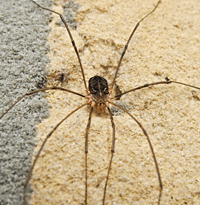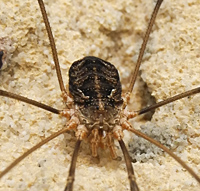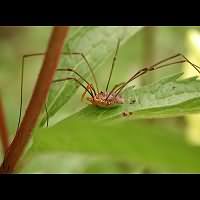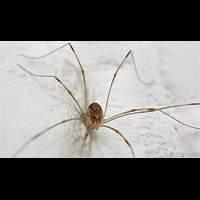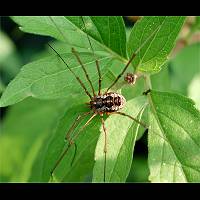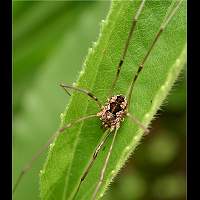[All pictures of garden wildlife on this page are thumbnails. Click on any thumbnail for a large format to be displayed.]

Common Harvestman (Phalangium opilio)
| Taxonomy | ||||||
|---|---|---|---|---|---|---|
| Kingdom: | Phylum: | Class: | Order: | Family: | Genus: | Species: |
| Animalia | Arthropoda | Arachnida | Opiliones | Phalangiidae | Phalangium | P. opilio |
The Common Harvestman is a variable species. The basic colour of the back varies from grey to yellowish or reddish brown. The stomach side is always white. Females give the impression of being darker than males. This is because of the broad and two times indented white line running over the sides. The females are similar to another species: Mitopus morio. In males the same indented line is present but it is much darker and less outstanding. They do have very impressive chelicerae (fangs) though. These protrude the head and are hollowed out from below. Males usually have a bodily length running 4 to 6mm, females are slightly larger, varying from 5 to 7mm.
Males fight among each other over the females, using their big fangs as weapons. After mating the male must hurry off, for the females will not hesitate eating him given the chance. This behaviour is shared with a number of spider species, such as the infamous black widow. The eggs of the common harvestman are spherical, measuring some 0.4mm in diameter. They are deposited in groups consisting of 50 to several hunderds of eggs. They are being laid in soft soil frequently. Other moist places, such as cracks in tree bark, are also often used. The females have a short, but stout ovipositor, a needle shaped organ with which the eggs are being laid. Fresh eggs are white, but they turn greyish brown rather soon. In moderate climates the eggs are laid by the end of summer and in autumn and overwinter as such. Nymphs are similar to the adults, except for the legs which are relatively (much) shorter. It takes them some 3 or 4 months to become adult.
The Common Harvestman is mainly a carnivore, but it will eat soft parts of plants if it has to. It mainly eats soft bodied, small animals, such as caterpillars, worms, beetle larvae, aphids, woodlice and other harvestmen. It is capable of catching small insects in flight by sticking some of its long legs into the air. Cannabalism occurs infrequently. The Common Harvestmen is experimented upon to see if it can be used in agriculture as a natural pest control. With very few exceptions the results are not too promising. The Common Harvestman will not only eat the pest insect itself, but also useful parasites and hunters for the pest insects, such as mites.
The Common Harvestman lives over much of the Northern Hemisphere: Europe, Northern Asia, Northern Africa and Northern America. In warm areas it has two and sometimes even three generations a year. In these warmer areas it may overwinter as egg, nymph or adult. Where winters are longer and more severe it overwinters being an egg only. This is one of the most common harvestmen in the world, including Great Britain and most of Canada and the USA.
The bottom two photos shows the colourful female of Phalangium opilio.

© Copyright 1998-2024 gardensafari.net (Hania Berdys)

 English / engels
English / engels  Dutch / nederlands
Dutch / nederlands